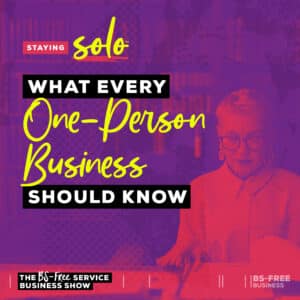
Search the site:
The Real Cost Of Growing a Service Business
Get ready to dive into the nitty-gritty of growing a service business as we kick off a brand-new series on the BS-Free Service Business show. In this episode, I’ll share the unfiltered truth about the real costs of growing a service business. In a world filled with facades and financial uncertainty, it’s time for some real talk.
I’m excited to be back and kicking off a new series here on the BS-Free Service Business show, “The Real Cost Of”. My goal for these episodes is to give you the actual cost of running a business, including tech and tools, content creation, boundaries, building an agency, and more.
The market has shifted and changed, and it’s time to talk about the facts of what things truly cost. In a market full of smoke and mirrors, alongside economic uncertainty, we need real talk now more than ever.
In each episode, I’ll dig into costs in actual dollars and the harder-to-quantify costs like energy, opportunities, time, and much more.
Today’s episode is on the real costs of growing a service business, including a few things that may surprise you. Plus, you’ll want to listen until the end for a fun surprise as I celebrate my 10th podcast anniversary.
What’s the Real Cost?
Let’s start off by talking about the concept of the real cost, as many times when we talk about cost, we’re referring to money. The concept of cost is often inflated with the price, but these are two unique things.
According to Dictionary.com cost is a “measure of what the company or business spends to produce the product before it can be sold.” Price is “what your customer is willing to pay.”
When talking about the real cost, we’re essentially tallying up all the “costs” that go into running our business, and that’s not always about monetary value.
Growing a Service Business: It’s Complicated
One of the biggest reasons people gravitate to the service business model is that it’s relatively easy to start. The barriers to entry are lower than other business models such as a product business or a retail location.
I had a used laptop and some business cards when I started my business. With an investment of $500 (in 2024, that’s about $820) I had enough to get started.
Not needing much startup capital is one of the biggest benefits of a service business, but that should not be mistaken for the fact that it’s easy. While you’re not making a massive financial commitment, you’re making up for it by investing your time and energy, especially in those early years.
While I’m a one-person hype squad for the benefits of having a service business, it’s important that every one of us recognize it’s more complicated than most people led us to believe.
For example, celebrity entrepreneurs sell the benefits of leaving a stable 9-to-5 job by telling people they can replace their income quickly by landing a few clients. This advice is oversimplified at best and irresponsible at worst.
I signed my first client within a few days of starting my business, and I landed a major client six weeks into my new venture. It may seem like pure luck, but it was anything but. This happened because I’d spent five years building a strong professional network in a specific niche.
The truth is results may vary. I did a quick poll on Threads, with 126 people sharing how long it took them to get their first paying client. 62% said less than a month, 21% said one to two months, and 17% said two months or more.
I also asked people where they found their first client. There were many responses, but most people found that their first client was through an existing connection. However, we can’t automatically assume people have these connections when starting a business.
While every service business relies on finding clients, the “how” of doing that is often intangible. As a marketer, I understand the cause and effect of how clients end up working with me, but after nearly 19 years, it still feels a bit magical.
That intangible part of finding clients is often sold as “client attraction” which is another great example of how oversimplified advice makes people think having a full client roster will be easy. Truth? There is no such thing as client attraction, you can’t just sit back and wait for clients to come to you. You need to have a proactive plan to bring in new clients consistently.
Now, look at the “costs” of growing service businesses, including a few that may surprise you. Remember, this goal is not to discourage you but to help you make informed choices about how and when you grow your business.
Hidden Costs: When Time is Money
One of the common refrains about those of us who work with clients is that we’re trading time for dollars. While I often argue that is the exact nature of work regardless of the type of business, the reality is that a service business requires you to invest your time.
The amount of time growing your business consumes depends on your choices, but it’s important to note that most necessary activities demand a time commitment.
This is obvious, but in my experience, most service business owners struggle with balancing the time required to serve clients and complete client work and the other aspects of the business.
There’s a tendency to undervalue the cost of investing our time. Even if we’re feeling spread thin between our personal and professional lives, it’s easy to think we should work a couple more hours because that’s “what it takes”.
Plus, we can fall into the trap of being “scrappy” when financial resources are limited. Sometimes, that’s necessary, and other times, we are literally our own worst enemy. Case in point, I can’t tell you how many times I’ve spent five hours on something only to realize that’s many hours of billable time, and getting help would have been a fraction of the cost.
Getting a handle on how you spend your time is critical to growing your service business. If you’re unsure, commit to tracking your time in detail for at least two weeks, and then sit down and analyze where your time is going.
For your client work, look for places where you’re overservicing or wasting time. With the remainder of your time, evaluate if that time is being spent in a way that’s helping you accomplish your goals. For example, if you need to sign new clients, but all your time is spent tinkering with your project management system, you must shift your priorities.
Energy and Emotional Cost of Client Services
What is the best part of a service business? The clients. The worst part of a service business? The clients.
If you’ve ever had a client from hell, you know the energetic and emotional costs of being a service provider. Luckily, these are usually few and far between for most of us, and over time, you get better at screening them out
That’s not to say that it’s just the bad clients. Even the best client relationships can drain your energy and mess with your emotions if you’re not proactively managing this cost.
This often shows up in the form of too many projects, calls, deadlines, emails, etc. This is why setting and keeping our boundaries is key, even if you absolutely adore your clients. (I will discuss the real cost of bad boundaries and burnout in a future episode.)
We all have a hard limit on our energetic and emotional capacity. That will vary based on the season of your life you’re in, as well as your unique needs.
In my case, I’m introverted and have ADHD, anxiety and depression. I’ve had to unlearn my tendency to go full throttle with my business so I’m not running on fumes. That means protecting my calendar, saying no to clients and potential opportunities, and more.
How you protect your energetic and emotional capacity may vary, but remember that this is a people-driven business, which can be downright exhausting for even the most extroverted people lovers.
This is another place where time tracking can be helpful as you can see where you may need to approach things differently. As you track time, consider adding notes about your energy level and emotional state. That way you can see the relationship between how you spend your time and the energetic (and emotional) cost of growing your business.
Personal Trade-Offs for Freedom and Flexibility
In looking at the costs of running any business, no conversation would be complete without discussing personal costs.
Glossy marketing pitches entrepreneurship as about “freedom” and “flexibility” while glorifying hustle culture and rampant capitalism. The truth about our choices to own our business is in the middle.
Yes, there’s freedom and flexibility, but there’s also a tangible personal cost. During some seasons, you may make sacrifices to pursue this path, including financial stability, job security, time with friends and family, or other things.
Honestly, it’s a trade-off, and it comes down to what personal choices and costs you’re willing to make. It doesn’t have to be dramatic, but it’s a far cry from the shiny, happy image of successful business owners with perfect lives online.
When you’re going through periods of growth in your business, you may make choices that have a personal impact. There have been times I’ve lowered my personal salary to make key business investments or opted to take on a client that would require me to work a little more.
That said, those were short-term decisions, not ones that I was willing to absorb the personal cost of for months or years. This is a big reason I encourage my clients not to constantly pursue growth as the costs often become too steep and compound over time.
The Price of the Dream
Finally, let’s discuss the financial costs of growing a service business. While this business model is less resource-intensive than others, there’s still a financial cost involved.
The biggest cost in a service business is always labor. If you’re a solopreneur, your salary should be one of the biggest line items on your budget and balance sheet. If not, I encourage you to use the personal salary goal calculator to figure out how much money you need to make to make this a reality.
We’ll discuss the real costs of this for agency owners or those of you with a team in an upcoming episode.
The other major costs you need to consider (and manage carefully) are:
- Marketing Costs
- Professional Fees
- Tech and Tools
- Training and Development
- Travel and Events
- Taxes
- Processing Fees
- Other Overhead
These costs may vary based on your type of business, target client and more. The key is that you’re considering the costs of running and growing your service business in a way that enables you to ensure you’re not overextended and can pay yourself. I’ll be doing a deep dive into the costs of content creation and tech and tools for solopreneurs during this series, as both are full of hidden costs.
Due to how the dream of owning a business is sold, it’s been normalized to overinvest in the business to grow. A service business should be run in a way that’s lean and enables you to support yourself. Otherwise, the personal, emotional, and energetic costs will add up quickly.
Growth Comes at a Cost Beyond the Cash
In wrapping up today’s episode, I want to remind you that this series isn’t meant to discourage you but to drive you to make informed choices for you and your business.
In the next episode, we’ll continue the series by looking at the real cost of tech and tools for solopreneurs. For more real talk about growing your service business, sign up below for the new Staying Solo Private Podcast.


I’m Maggie Patterson (she/her), and services businesses are my business.
I have 20+ years of experience with client services, am a consultant for agency owners, creatives, and consultants, and vocal advocate for humane business practices rooted in empathy, respect, and trust.
Help Not Hype

Tired of the same old BS business advice?
I got you with weekly emails packed full of proven strategy that makes a real difference in your service business.









